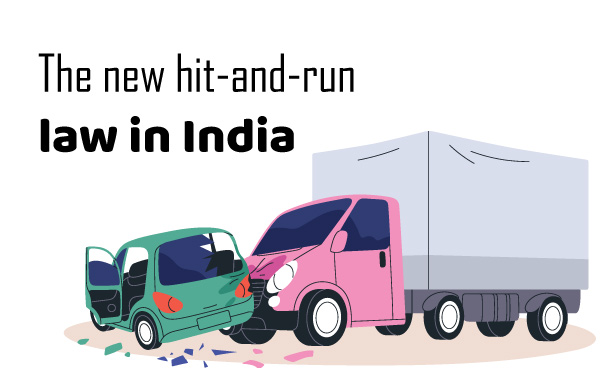Hit-and-Run New Law: Provisions, Significance, and Concerns (GS Paper 2, Governance)

Context:
- The new hit-and-run law introduced as part of the Bharatiya Nyaya Sanhita (BNS), 2023, aims to address the increasing incidence of hit-and-run accidents in India.
- These accidents often involve drivers who flee the scene, depriving victims of timely medical assistance and justice.
- The law replaces older provisions under the Motor Vehicles Act, 1988 and the Indian Penal Code (IPC), which were seen as lenient and ineffective in curbing such incidents.
What Are Hit-and-Run Accidents?
- A hit-and-run accident occurs when a driver collides with a person, vehicle, or property and then leaves the scene without providing assistance to the injured or notifying authorities.
- These cases are considered severe because they often result in fatalities or serious injuries and reflect a violation of the driver's moral and legal duties.
Status of Hit-and-Run Law Before the New Law:
- Motor Vehicles Act, 1988: This Act mandates that drivers involved in accidents must stop, assist the injured, and report the incident to the police.
- Indian Penal Code (IPC):
- Section 279: Deals with reckless driving that endangers human life, carrying penalties of up to 6 months imprisonment or a fine, or both.
- Section 304A: Deals with causing death by negligence, with penalties of up to 2 years imprisonment or a fine, or both.
Why Was the New Hit-and-Run Law Needed?
Rising Road Accidents:
-
- 47,806 hit-and-run cases were reported in 2022, resulting in 50,815 deaths.
- Road accidents in India increase by 12% annually, with fatalities rising by 9.4% year-on-year.
- Despite only comprising 5% of India's road network, national and state highways account for over 50% of road accident-related deaths.
India’s Share in Global Road Accidents:
-
- India represents 1% of the world’s vehicles but contributes to 10% of global road accident deaths.
- Road accidents cost India 5-7% of its GDP annually.
Need for Stricter Driver Accountability:
-
- Previous penalties, including a maximum of 2 years imprisonment under the IPC for death caused by reckless driving, were seen as insufficient to deter unsafe driving practices.
Empowering Victims:
-
- The law aims to ensure victims of hit-and-run accidents receive timely compensation and justice.
Provisions of the New Hit-and-Run Law:
The new hit-and-run provisions under the BNS, 2023, introduce stricter penalties for drivers who flee the accident scene:
- Section 106(2): Drivers who leave the scene of an accident without reporting it to the police can face up to 10 years imprisonment and a fine. This provision aims to hold drivers accountable for fleeing the scene.
- Section 106(1): If the driver reports the accident to the police, acknowledging responsibility, they can face up to 5 years imprisonment. This provision also applies in cases of fatalities caused by rash driving.
The law is designed to increase driver accountability and encourage responsible behavior, potentially saving lives by ensuring quicker access to medical help for the victims.
Concerns and Opposition:
Despite the law's intention to enhance accountability, there have been concerns and protests from various groups, particularly drivers and transporters, against the provisions of Section 106(2) of the new law. Key concerns include:
- Potential Misuse: Drivers fear the law could be misused, leading to unjust penalties.
- Heightened Risk of Mob Violence: The stricter penalties could lead to more violent reprisals from the public, especially in cases where the accident is a minor one.
- Unfairness: Some claim that the law may be too harsh in certain situations, especially when the driver may have acted in a panic or without ill-intent.
- Inconsistencies with Existing Laws: The new law is seen as potentially conflicting with existing legal provisions, leading to confusion in enforcement.
Protests against the law have been observed in states like Maharashtra, West Bengal, Chhattisgarh, and Punjab, with drivers demanding either the withdrawal or amendment of Section 106(2). In response to these protests, the government has assured that all stakeholders, particularly drivers, will be consulted before the law is fully implemented. These consultations could have been more effective if conducted before the law’s announcement to address concerns early on.
Significance of the New Law:
- Enhanced Accountability: The stricter penalties are expected to hold drivers more accountable for hit-and-run accidents, reducing the number of such incidents.
- Timely Medical Aid: By encouraging drivers to report accidents, the law could improve the chances of timely medical intervention for accident victims, potentially saving lives.
- Deterrence: The introduction of harsher penalties for fleeing the scene is likely to act as a deterrent against reckless driving and evasion of responsibility.
Conclusion:
- The new hit-and-run law, as part of the Bharatiya Nyaya Sanhita (BNS), 2023, is a step toward strengthening road safety laws in India.
- While its intent to improve accountability and reduce fatalities is commendable, it has sparked protests due to concerns over potential misuse and fairness.
- The government's willingness to consult with affected stakeholders offers a path for refining the law and addressing these concerns.
- Ultimately, the success of the law will depend on a balance between stricter enforcement and fairness in its application.


